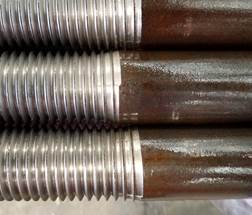 The thread runout portion of a bolt is where the threaded section transitions into the bolt shank. This area exists beyond where the usable thread stops. In other words, if you were to assemble a nut all the way onto a bolt, the nut will stop, but there will still be a small portion of thread which is unusable as it transitions into the smooth body shank of the bolt.
The thread runout portion of a bolt is where the threaded section transitions into the bolt shank. This area exists beyond where the usable thread stops. In other words, if you were to assemble a nut all the way onto a bolt, the nut will stop, but there will still be a small portion of thread which is unusable as it transitions into the smooth body shank of the bolt.
For more specific information in regards to the description of externally threaded fasteners, refer to ASME B1.1 or Inch Fastener Standards from IFI (Screw Threads, 2003, Section A).
As far as a maximum length of thread runout allowed, it is specifically defined for hex cap screws and heavy hex structural bolts, but not for a standard hex bolt. As stated in the ANSI/ASME B18.2.1 specification for hex cap screws and B18.2.6 for heavy hex structural bolts, there is a “Transition Thread Length (Y)” for a given diameter of bolt. Below is a chart showing the maximum length of thread runout allowed.
| Heavy Hex Structural Bolts | |
|---|---|
| Diameter | Transition Thread Length |
| 1/2 | 0.19 |
| 5/8 | 0.22 |
| 3/4 | 0.25 |
| 7/8 | 0.28 |
| 1 | 0.31 |
| 1 1/8 | 0.34 |
| 1 1/4 | 0.38 |
| 1 3/8 | 0.44 |
| 1 1/2 | 0.44 |
| ANSI/ASME B18.2.6 | |
| Hex Cap Screws | |
|---|---|
| Diameter | Transition Thread Length |
| 1/4 | 0.25 |
| 3/8 | 0.312 |
| 1/2 | 0.385 |
| 5/8 | 0.455 |
| 3/4 | 0.5 |
| 7/8 | 0.556 |
| 1 | 0.625 |
| 1 1/8 | 0.714 |
| 1 1/4 | 0.714 |
| 1 3/8 | 0.833 |
| 1 1/2 | 0.833 |
| 1 5/8 | 0.909 |
| 1 3/4 | 1.00 |
| 1 7/8 | 1.00 |
| 2 | 1.111 |
| 2 1/4 | 1.111 |
| 2 1/2 | 1.25 |
| 2 3/4 | 1.25 |
| 3 | 1.25 |
| ANSI/ASME B18.2.1 | |

Will the Nut STOP on rolled threaded studs, which will be having a lesser body diameter?
@Ashok – Yes, the nut should stop when it reaches the end of the threads, even with a reduced body.
What is the standard dimension of a thread runout?
@Tim- thread runout can vary wildly from manufacturer to manufacturer, and can vary between grades as well. Example structural grades like A325 require different thread lengths and control grip length more than general purpose grades like A449 or grade 5. We are not aware of any standard dimensions for runout – it is usually controlled more by regulating the thread length and grip length as opposed to specifying runout.
why runout is required?
@Zohad- Thread runout is not a requirement, but it is impossible to thread without leaving a little transition area. ASME limits the amount so that it is not excessive, but it will always be present to some extent.